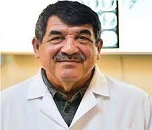Scientific Program

Alizamin Sadigov
Azerbaijan Medical University, Azerbaijan
Biography:
Alizamin Sadigov is a professor doctor with more than 30 tears of work experience in nursing, education, and research have graduated from Atlantic international university(AIU) in a doctorate and have received Ph.D. and MHSs degrees.Have graduated from Saint Petersburg medical university and have received a Medical Doctor degree. He also have two honored degrees: FCCP(Fellow at American College of chest physicians)and ATSF(Fellow at American Thoracic Society). He is the head of the pulmonary medicine department at the hospital clinic of a medical university.
Abstract
Chronic obstructive pulmonary disease (COPD) is a complex disease that requires differential diagnosis and proper classification to identify appropriate therapy. The Global Initiative for Chronic Obstructive Lung Disease(GOLD) guidelines classify a patient’s COPD and provide recommendations for first-line treatment .The 2021 update included information regarding the use od e-cigarettes as nicotine replacement ,triple therapy ,and how the SARS –CoV-2 virus impacted patients with COPD. However, our report will focused COPD exacerbations and mostly will cover the new approaches in prevention of COPD exacerbation. Exacerbations may be triggered by several factors ,most commonly infections of the respiratory tract. Conditions with nonspecific symptoms similar to a COPD exacerbation include pneumonia ,pneumothorax, pleural effusion ,pulmonary embolism, pulmonary edema ,and/or cardiac arrhythmias. The goal of therapy when treating a COPD exacerbation is to minimize the negative impact of the current exacerbation and prevent future events. In moderate –to-severe exacerbations ,in addition to the SABA, systemic corticosteroids and antibiotics may also be used for no more than 5 to 7 days to improve FEV1,shorten recovery time, reduce the risk of early relapse ,and shorten duration of hospitalization. The guidelines recommend the use of long-acting bronchodilarots throughout the exacerbation or start these medication as soon as possible before discharge. Infection with the SARS-CoV-2 virus may put a patient with COPD at increased risk of complications, including exacerbation and hospitalization. While patients with COPD may not be at an increased risk of infection, they may be at an increased risk of complications and hospitalization due to infection. If a patient with COPD contracts the SARS-CoV-2 virus ,there is no evidence that COPD medications should be altered and treatment should be the same standard of care that other COVID-19 patient receive. As this a respiratory virus ,it may trigger and aggravate COPD exacerbation ,all patients with COPD have to receive booster dose of vaccine against COVID-19.All patients infected with COVID-19 ,after this infection ,should undergo rehabilitation and follow-up. There is suggestions in prevention of exacerbation of COPD by using new treatment options including new combination of bronchodilators (dual and single) and ICS .And one of crucial moment of this suggestion is using low doses of ICS as content of triple therapy(LAMA/LABA/ICS) and achieve similar patient outcomes when using high doses of ICS. Recently published IMPACT and ETHOS clinical trials have been suggested the beneficial effect of triple therapy in reducing exacerbation of COPD. However, the use of high doses ICS as known, may associated with poor outcomes for patients including the risk of development of pneumonia. And ETHOS trial gave us new evidence about beneficial effect of triple combination with low doses of ICS with minimizing risk of development of pneumonia and other complications related to use of high doses of ICS. And furthermore, ETHOS trial suggested that triple therapy in patients with COPD may reduce all-cause mortality which most beneficial for any patient with this deadly disease. New findings regarding trip[le therapy suggest that there is a significant decrease in mortality in comparison to dual bronchodilation therapy and a decrease in exacerbations and hospitalization. The management of patients at follow-up is dependent on two treatable targets: dyspnea and exacerbations.
- COPD
- Asthma
- Pneumonia
- Lung Cancer
- Pulmonary Rehabilitation
- COVID-19

